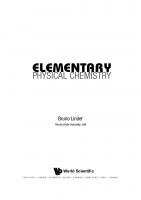Principles of Physical Chemistry [46 ed.] 9382956018, 9789382956013
340 68 70MB
English Pages [1404] Year 2013
Recommend Papers
![Principles of Physical Chemistry [46 ed.]
9382956018, 9789382956013](https://ebin.pub/img/200x200/principles-of-physical-chemistry-46nbsped-9382956018-9789382956013.jpg)
- Author / Uploaded
- B.R. Puri
- L.R. Sharma
- M.S. Pathania
File loading please wait...
Citation preview
Comprehensively Covering the B.Sc. and M.Sc. Syllabi Prescribed by the UGC Also catering to th~ ne11f!; .;istudents apptraring i~iarious cainpeti(i~e-~xa .
Late B.R. PURI M.Se-, Ph.D" F.R.I.C, F.NA, Professor of Physical Chemistry, Panjao University, Chandigarh
MADAN S. PATHANII\-
1.R, SHARMA M.Sc., Ph.D .. fR.tC. (London). foonerly, Professor of Physical Chemistry, Department of Chemical Engineering & Technology, Panjab University, Ch_andigarh
•
• 'M-Sc., Ph.D_ (Wllst Viiyinia University, U.SA). · Formerly, Professor of Physical Chemistry. Panjab University, Chandigarh
VISHAL PUBLISHING CO.
Published by:
VISHAL PUBLISHING CO. Adm. cum Head Office : BOOKS MARKET, OLD RAILWAY ROAD, JALANDMAR,144 008 (PB.) INDIA,' Ph.: (0181) (0) (3450403, 5005403-05 (R) 5005401, 5005402 • • E-mail : [email protected], [email protected] Sales Office : 4271/XI, 3-Ansari Road, Daryaganj, Delhi - 110 002 Ph. 011-23260206
First published: July, 1962 · ©Copyright Reserved : 2012·-2013
"No part of this publication which is material protected by this copyright notice may be reproduced or 'ronsmitted ar utilized or stored in any form or by any means now known or hereino~er invented, electronic, digital or mechanic.al, including photocopying, scanning, recording or by any information, storage or retrieval system, without prior written permission · from the publisher."
. Price :
{ 550/- (for Pb., Haryana. H.P., J&((and Delhi) { 560/- (For other srat~sl { ~ 850/- (Libmy & International Edition)
ISBN: 81-88646-74-l
Information contained in this book hos beert published by Vis ha I Publishing Co., and has been obtained by its authors from sources believed to be reliable and are correct to the best of their knowledge. However, the publisher and its authors shall in no event be liable for any errors, omissions ordomoges arising out of use of this·information and specifically disclaim o~y implied warranties ormerchontobilityor fitness forony p_orticular use.
Printed at l:lstant Printers Jalandhar
I
.,·.t
~------------------·--·-----·---PREF ACE TO THE
46th EDITION
'This is the Golden Jubilee Year of the publication of the Principles ofPhysical Che;mistry and the occasion calls for some kind of celebration. It is a matter of immense pleasure and satisfaction that this text has successfully retained its prestigious position for five decades (the first edition of the book appeared in l 962}. Thjs has been due to the fact-that we have been reyising the book almost every year to highlight modern topics. At several places the text has been thoroughly revised. Physical chemistry ·is traditionally divided into three parts-structure, equilibrium, change-and usually taught in that sequence though certain topics ~annot be neatly accom_modated in this scheme. The syllabus suggested by the UGC broadly conform"s to this pattern and we have produced a text"whicli"deals with the . subject in a rigorous and comprehensive way to cater to the needs of the graduate and post-graduate students of physical chemistry in the Indian universities and colleges. The significant feature of this edition is that two new chapters have been ad_ded: Quantum mechanics is· dealt with in three chapters, instead of the earlier two, and statistical thermodynamics is spread over two chapter_s. Some material has been shifted at several places within the chapters to maintain continuity and impart lucidity and simplicity to the treatment. Structure dominates science and chemistry is no exception. And quantum mechanics and spectroscopy are the chemist's tools to deal adequately with structure. Complete quantum mechanical treatment of the hydrogen ·atom, with special e.mpliasis ~n the detaikd solution of the S"chr6dinger equation, has been given·. The radial equation and the spherical harmonics have a·t last received the emphasis they really deserved. Also, the approximate methods. fqr . the wave mechanical treatment of many-electron atoms have been updated. The_ perturbation theory,--both non-degenerate and degenerate-has been adequately dealt with· and applied to the (ii-st excited state of hydrogen atom. Several other modern topics which were earlier wr_itten as.Appendices



![Essentials of Physical Chemistry [Multicolour Edition]](https://ebin.pub/img/200x200/essentials-of-physical-chemistry-multicolour-edition.jpg)
![Principles of Physical Biochemistry [2ed]
0130464279, 9780130464279](https://ebin.pub/img/200x200/principles-of-physical-biochemistry-2ed-0130464279-9780130464279.jpg)


![Physical Chemistry [4 ed.]](https://ebin.pub/img/200x200/physical-chemistry-4nbsped.jpg)
![Physical Chemistry [4 ed.]](https://ebin.pub/img/200x200/physical-chemistry-4nbsped-e-5775343.jpg)
